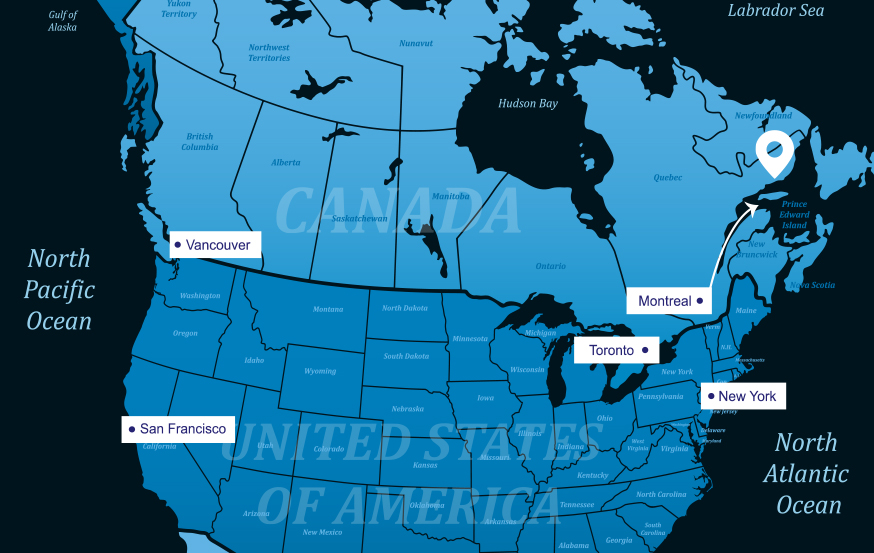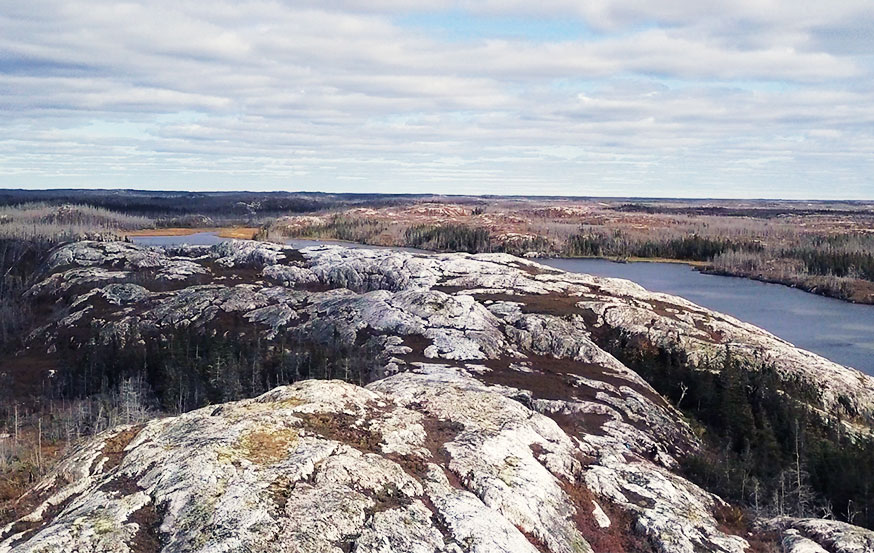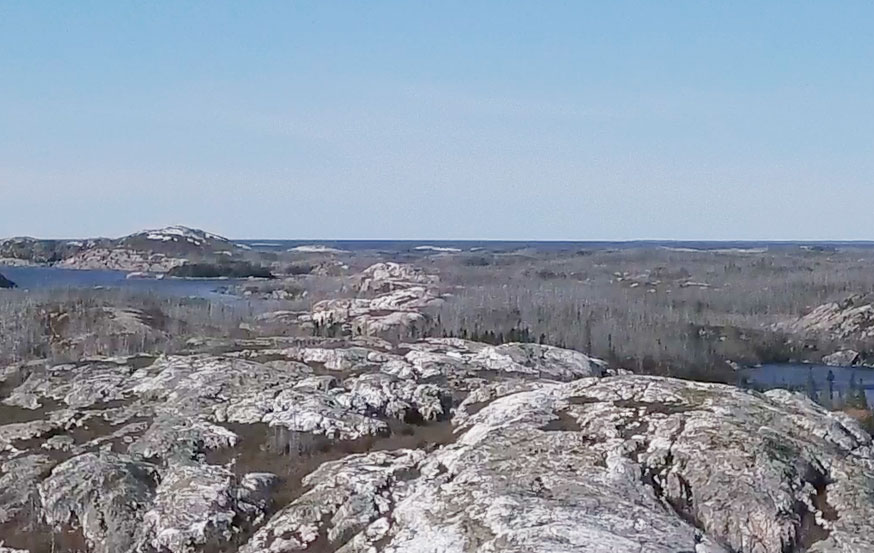Our Baie-Johan-Beetz hydrothermal deposit

Generally, the ground slowly rises north from sea level, up to 180 m above sea level. The quartz veins of Johan Beetz can be observed rising from the St-Lawrence and are heading North-East all the way to road 138, for approximately 4 km. A practical dirt road goes from Road 138 toward the Property.
The area is sparsely vegetated with moss and lichens on some outcropping rocks, and small patches of spruces. Vegetation is more abundant and of a wider variety going North. The mining titles owned by PAL correspond to the past mining claim ML 794 and have a surface of 54.27 hectares (542 700 m2).

In 2019, the Fraser Institute ranked Quebec Mining market as the 4th most attractive area in the world for mining investment.
Our Baie-Johan-Beetz hydrothermal deposit in video
6 key advantages of Baie-Johan-Beetz deposit.
01. Location opportunity
- 13km east of the village Baie-Johan-Beetz
- Deposit is less than 800 meters from main provincial road (route 138)
- 69 km from town of Havre-St-Pierre and its airport
02. Easy export
- 290km from Sept-Iles industrial harbor
- 15 km from Baie-Johan-Beetz’s deep water dock
03. Easy operation
- Hydrothermal quartz is on surface
- Mining lease type is Surface Operation
- Scarce surface vegetation
04. Excellent business opportunity
- Advantageous governemental policies due to surface deposit type operation
- Possible support from local and state governments
05. Labor
- Qualified workers available
- Numerous job seekers in the region
- Surrounded communities in need of jobs
06. Sustainable footprint
- The open pit extraction method lowers the overall footprint
- The available hydroelectricity power allows the use of greener technologies, such as SOLSILC
- The advantageous location of the deposit reduces transport
Geology
Johan Beetz area geology consists of quartzite, gabbro and granitic gneiss along Watshishou Hill. Costabelle regional fault is the main structural feature of the area running roughly to the North North-East from the St-Lawrence. Costabelle fault was flushed with hydrothermal fluids producing the milky quartz. Pegmatite dykes brecciated the Costabelle fault area.
Prospections campaigns of four (4) km of the fault, from the St-Lawrence, identified ten bodies of milky quartz. Grenville Province, on which Johan Beetz quartz deposits are found, also hosts many known quartz deposits. These deposits, as the Baskatong milky quartz, the St-Donat-de-Montcalm and Charlevoix quartzite ore bodies are used for Si-metal purposes.
Here is an evaluation of the outcropping quartz veins considering the latest hand measured length, width, and above surface of all 10 showings.

Vein #2
The Quartz vein 2 is also named White Hill. White Hill is barren of any overburden. It has been sampled numerous times over the years, from 1944 to 2011 to analyze its purity. There is a Table cumulating the results of the different oxides present in the quartz vein, the silica content and bore results with two (2) analytical methods (Valuation and Mineral Potential of Johan Beetz Quartz Deposit, QC, Canada - Final Report, february 21st 2014).
Vein 2 is directed East-West. A North-South fault cuts Vein 2 at approximately one third of its Western end. This Western portion of Vein 2 is highly contaminated in iron and aluminum oxides hence not suitable for metallurgy. Appropriate selective mining methods would expect a loss between 15 and 50%.
1 742 600 mt = Conservative Minimal Indicated Resources (33,5%) - Vein 2.
Vein #9
Vein 9 is oriented approximately East-West and is located 120 m West of Vein 2.
507 200 mt = Conservative Minimal Indicated Resources - Vein 9.
These metrics do not account for below ground level quartz ore. It is expected that these estimated basic bulk tonnage will dramatically increase when the delineation and depth of the quartz bodies will have been investigated.
A drilling campaign will determine the depth of the quartz ore bodies, hence multiply the raw bulk tonnage, and defined with greater accuracy the quality of the quartz, and, increase as well, the market value of the Property.
Valuation of PAL's mining titles
On PAL’s mining titles the indicated resources for Veins 2, 9 and 10 are + 6M mt. On the Johan Beetz seven (7) other veins, the indicated resources are + 11M mt.
In order to compare the value of the mining titles based on the observed indicated resources, prior to a drilling program which will only highly increase the bulk tonnage two (2) similar deposits will be briefly discussed.
Kvinnherad quartz deposit, Nesodden area Norway
Kvinnherad is a high purity quartz deposited with estimated resources of 2.7 M mt exposed on a step forested mountainside (based on field mapping 12 m x 600 m x 150 m). The geological setting and size of vein is similar to Johan Beetz. Frequently observed impurities are K and Fe oxides. Analytical data from the lab Dorfner Anzaplan indicates level of boron and phosphorous similar to le levels in Vein 2 of the studied Property PAL. Open pit mining is planned. The application for Kvinnherad beneficiated quartz would be semi-conductor, and fuse quartz for light bulbs. A total of 50K tons would be mined to supply the plant with 20 000 tons/year to produce 5 000 tons per year of ultra pure silica. The site has a 30 years potential and paid back after
Lighthouse quartz deposit, Australia
A deposit of quartz and silica sand of 1.8M mt was sold at $307M USD to Solar Silicon Resources Group, in Queensland, Australia in 2010. The silica content at the Lighthouse deposit ranges from 98.3% up to 99.5%. The Lighthouse quartz deposit was operated as an open pit. During 10 years, they proposed to produce solar grade silica. Sea access is at 250 km from the deposit.
PAL’s property value should be at least similar to the Lighthouse project, circa $300M USD based on observations in this report.



